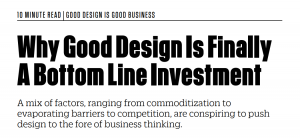This is going to be one odd topic, but I was asked to think about thinking. If that’s too confusing for you, it’s also called metacognition.
According to a lesson by Amy Carlson, she defined metacognition as:
Being aware of what you know and don’t know, understanding what you will need to know for a certain task and having an idea of how to use your current skills to learn what you don’t know.
To be honest, this definition confused me even more.
So I decided to come up with questions to helped me with this confusing topic: When was the last time I thought about thinking? How did I think that certain way? What are the processes I go through when I think?
After days of thinking about thinking, I still don’t have a clear idea what it really is, but this is what I got from it.

(Image: peartreedesigns)
As a designer, I have an eye for all things creative. I realized I tend to look for things that are quirky and weird.
Reading books and novels were always difficult for me. A reading from my business class called Question Everything by Robert Cruger took me a good 30 minutes to get through 6 pages of text because I can’t keep my focus on a bunch of words. I’m a person who loves short cuts – especially in reading. I tend to skim through text, and I pick out the things I want to read.

Here’s why:
- I am a lover of numbers – Whenever I see a list of items, I get captured. I try to understand each number listed first before reading anything else.
- Any design captures my attention – This is because I am a designer. Anything out of the blue will capture me, just like the circled quote of Jane Fulton in the picture above.
However, even if I skipped all the details, I would have to go back and read the blocks of text to understand the article fully.

This is probably why I’m always the slowest reader. I realized this through another required reading in my class called Why Good Design is Finally a Bottom Line Investment. It wrote “10 Minute Read” in the top right corner, but took me a good hour to understand it. I thought I was with the norm until I asked how long it took my peers to read it – they said 10 minutes. The hour I spent reading the article probably consisted of getting distracted by the visuals and quotes. This includes searching up the meanings of all the words I don’t understand.
All the decisions we make everyday are different, then we reflect on the consequences of each action to learn from them. For example, I’ve used the different tools in this blog, such as inputting links and pictures, because I’ve had great blogging experience using them.

(Image: The Learning Cycle)
It’s crazy to think that every action that we take are almost certainly learned from things we have encountered in the past. As stated by Schön in The Reflective Practitioner:
In “reflection-in-action”, doing and thinking are complementary. Doing extends thinking in the tests, moves, and probes of experimental action, and reflection feeds on doing and its results. Each feeds the other, and each sets boundaries for the other.
Right now, I’m still confused as to how I think. Hopefully, the quirkiness and weirdness I’ve expressed here and there showed you how I, a designer, like to think.
Cheers,
A.
Citation:
Carlson, A. (2003). Metacognitive strategies: Definition & examples Retrieved from http://study.com/academy/lesson/metacognitive-strategies-definition-examples-quiz.html
Cruger, R. (2007). Question Everyday. Retrieved from http://5a5f89b8e10a225a44ac-ccbed124c38c4f7a3066210c073e7d55.r9.cf1.rackcdn.com/files/pdfs/news/QuestionEverything.pdf
Kuang, C. (2015, April 17). Why Good Design Is Finally A Bottom Line Investment. Retrieved from https://www.fastcodesign.com/1670679/why-good-design-is-finally-a-bottom-line-investment
Schon, D. (2012, December 18). The Reflective Practitioner. Retrieved from https://graysreadinggroup.wordpress.com/2012/12/18/the-reflective-practitioner-by-donald-schon/
